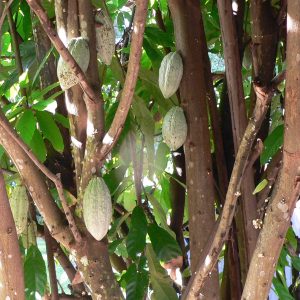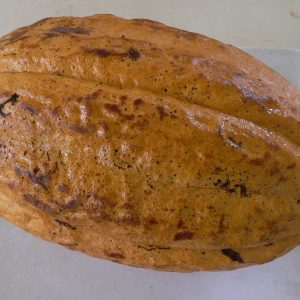Theobroma cacao
Cacao, cocoa tree
Origin
Believed to be native to the upper Amazon regions, subsequently spread to meso-America and then from Columbian times elsewhere throughout the tropics.
Climate
This species is an ultra-tropical adapted to lowland (less than 300m altitude) rainforests of meso-America ideally within 10 degrees north or south of the equator and which requires a moist environment. Temperatures under 20°C reduce growth, flowering, fruit yield and quality. Optimal growth is in areas with well-distributed annual rainfall of 1500-3000mm.
Plant Description
It is a small understory tree, 4-8m high. Mature dark green leaves are simple, 15-40cm long.
Relatives
Malvaceae Family. Relatives include kola nut and cupuassu. There are, in fact, a number of Theobroma species, some of which have the local name ‘Mountain Cacao’ and which grow at higher altitudes. This leads cocoa fanciers to hope that, somewhere, there are cultivars that are more cold-hardy than T. cacao.
Soils
Soils should be fertile and deep.
Propagation
Seeds are recalcitrant and viviparous. Seed pulp has to be removed for germination, and emerging seedlings need more than 50% shading for at least the first 6 months.
All vegetative means of propagation are possible but present various difficulties in use. Budding and grafting seem to be the most widely used currently in South East Asia and Brazil.
Cultivars
Amazon cacao, which in the trade is called ‘forestero’ cacao, has purple-coloured seeds. Central American and some Venezuelan cacao, called ‘criollo’, has white seeds. Forestero trees are good producers, but criollo produces a better quality of chocolate. ‘Trinitario’ is a trade name for another class of cacao which is a cross between forestero and criollo. There has been some success in producing improved varieties through hybridisation and selection of disease-resistant clones.
Flowering and Pollination
Inflorescences are cauliflorous, borne in leaf axil scars in small fascicles. Flowers are perfect with white petals.
Under optimal conditions trees may start flowering within 2 years. Cacao is morphologically and genetically self-incompatible and generally needs cross-pollination via midges. Self-pollination is more likely with cultivated than wild varieties and may occur via crawling insects such as ants and thrips.
Cultivation
As an understory tree, a shaded location is preferred. Regarding fertilization, the largest macronutrient requirements are for N, K and Ca followed by Mg and P. Depending on soil fertility and pH, all the micronutrients may also need to be supplied regularly. Mature producing trees require more K than N (150%).
Wind Tolerance
Trees are very sensitive to winds, resulting in defoliation.
Pruning
Pruning of mature trees is mainly of two types: sanitary, to remove dead or diseased branches and structural, to limit height and keep the canopy open to sunlight.
The Fruit
The ellipsoid fruit, smooth or ridged, weighs up to 300g and has a thick skin coloured green, yellow, red or purplish.
Fruit Production and Harvesting
Mature trees can produce 50,000 flowers but fruit set may only be 1%. Fruit require 5-7 months to mature; harvesting is manual, staggered over a few months.
Fruit Uses
The soft, sweet and edible white flesh surrounds 20-40 ovoid seeds which when dried and powdered are used to prepare cocoa and chocolate.
As well as the familiar forms of manufactured chocolate, the pulp can be eaten fresh or frozen and made into juices, jellies, ice cream and other sweets. It contains about 17% sugars.
Pests and Diseases
With its preferred climate of hot, humid conditions, cacao suffers from heavy disease problems; pests less so. Each producing area of the world has its own specific diseases but Phytophthora (pod rot) is the most important disease worldwide.
Comments
For those of you who like a real challenge, this one could be for you here in the South West of WA. Maintaining appropriate humidity, irrigation and minimum temperatures represent major obstacles to be overcome. Plus if you have a seedling, you have to hope it will be self-fertile!
More Information
Cocoa, chocolate and the food processors
We’ve all been told in health documentaries, magazines, news reports etc. that chocolate in moderation is good for you. It’s delicious and the problem for almost everybody is that it can be hard to stop at only a few squares without eating the whole block in one go. It’s a high calorie food because of the high fat content and the usual addition of milk products and sugar. Dark chocolate, where these additives are reduced or absent is healthier but is far less popular because of the reduced sweetness – to many it just tastes unpleasantly bitter. Chocolate is made from ground cacao bean kernels that come from the fruit tree Theobroma cacao. World production is centred in tropical countries, mainly west Africa.
After harvesting, the pods are broken, much of the flesh is removed and the seeds are then fermented, dried and exported worldwide. The kernels are roasted and pressed to extrude the cocoa butter primarily for chocolate production, and the remaining solid cocoa cake is dried and ground to produce cocoa powder. Separation of the two is not complete, but the powder contains a much higher concentration of health-promoting flavonoids (variable but average of 261mg/100g compared to 53 and 15 mg/100g in dark and milk chocolate respectively) and has lower calories (370 and 550kcal/100g respectively). There is also evidence that the milk products and sugars added to chocolates reduce flavonoid activity, and a further consideration is that the average serving size for cocoa powder is 3g, while the size for dark and milk chocolate is 17g and 32g, respectively. So if cacao products are eaten from a nutritional viewpoint rather than straight enjoyment, cocoa powder has the best of both worlds – higher effective flavonoids and lower calories. What does the research say about consuming cocoa powder? The following is a summary of a study published in the International Journal of Medical Sciences (2007), 4, 53-58.
Substantial data suggest that flavonoid-rich food could help prevent cardiovascular disease (CVD) and cancer. Cocoa is the richest source of flavonoids, but current processing reduces the content substantially. The indigenous Kuna Indians living in the Panamanian San Blas islands drink a natural flavanol-rich cocoa as their main beverage. This provides more than 900 mg/day and probably means they have the most flavonoid-rich diet of any population worldwide. We used diagnosis on death certificates to compare cause-specific death rates from year 2000 to 2004 on the mainland and San Blas islands where only Kuna live. In this period there were 77,375 deaths on the mainland and 558 deaths in the San Blas. As anticipated on the mainland, CVD was the leading cause of death (83 age adjusted deaths/100,000) and cancer was second (68). In contrast, the ageadjusted rate of CVD and cancer among island-dwelling Kuna was much lower, 9 and 4 respectively. Similarly, deaths due to diabetes mellitus were much more common on the mainland (24) than in the San Blas (6). This comparatively lower risk among Kuna in the San Blas from the most common causes of morbidity and mortality in much of the world possibly reflects a very high flavanol intake. However, many other risk factors could possibly be involved and an observational study such as the present cannot provide definitive evidence.
The authors are commendably cautious in recognising their study is not the last word on this topic, and recommend further work in the field. But given such a major impact on the common western chronic diseases, the question for individuals is – should I include some cocoa in my diet now while waiting for more exhaustive studies, or is it best to wait till the story has been overwhelmingly settled in perhaps the next 10 years? The authors of the above study did consider or evaluate some of the more obvious possible contributing factors. For example, genetic differences in the two populations are unlikely to be responsible because when the Kuna migrate to the mainland they rapidly acquire the same disease incidence as the mainlanders, they are an older population than the mainlanders which normally would lead to increased disease rates whereas theirs were lower, diet components in the two locations are not significantly different apart from cocoa, and so on. In addition to this study there are now many others focussed on different aspects and using different approaches, and generally they all point in the same direction – cocoa is good for you. The 900mg/day intake of the Kuna compares with average flavonoid intakes in the US, UK, Ireland and Australia of 190, 182, 177 and 130mg/day respectively.
A very common intermediate step in cocoa kernel processing is called alkalisation. This raises the pH, causes colour changes, reduces bitterness and improves water miscibility, but most importantly can destroy a lot of the beneficial flavonoids. If heavily alkalised, less than 5% of what was initially there may be left. Food processors accommodate the dominant sweet preference of consumers by alkalising, so that almost all retail supplies of cocoa powder will have been treated.
The US requires alkalised cocoa products to be labelled as such, but here some dogged detective work will be required to track down ‘natural’ cocoa powder if you want the full nutritional benefits. After bean fermentation which we have little/no control over, alkalisation is the principal cause of flavonoid loss. Most of the 5000-odd flavonoids known in plant materials are heat labile, but fortunately the main ones in cocoa are more resistant. This means cocoa powder can be incorporated into baked products such as biscuits, muffins and cakes without causing significant loss of nutrient benefits. However if some degree of rising is required, baking soda should be avoided, as it is alkaline and will result in major flavonoid breakdown.


